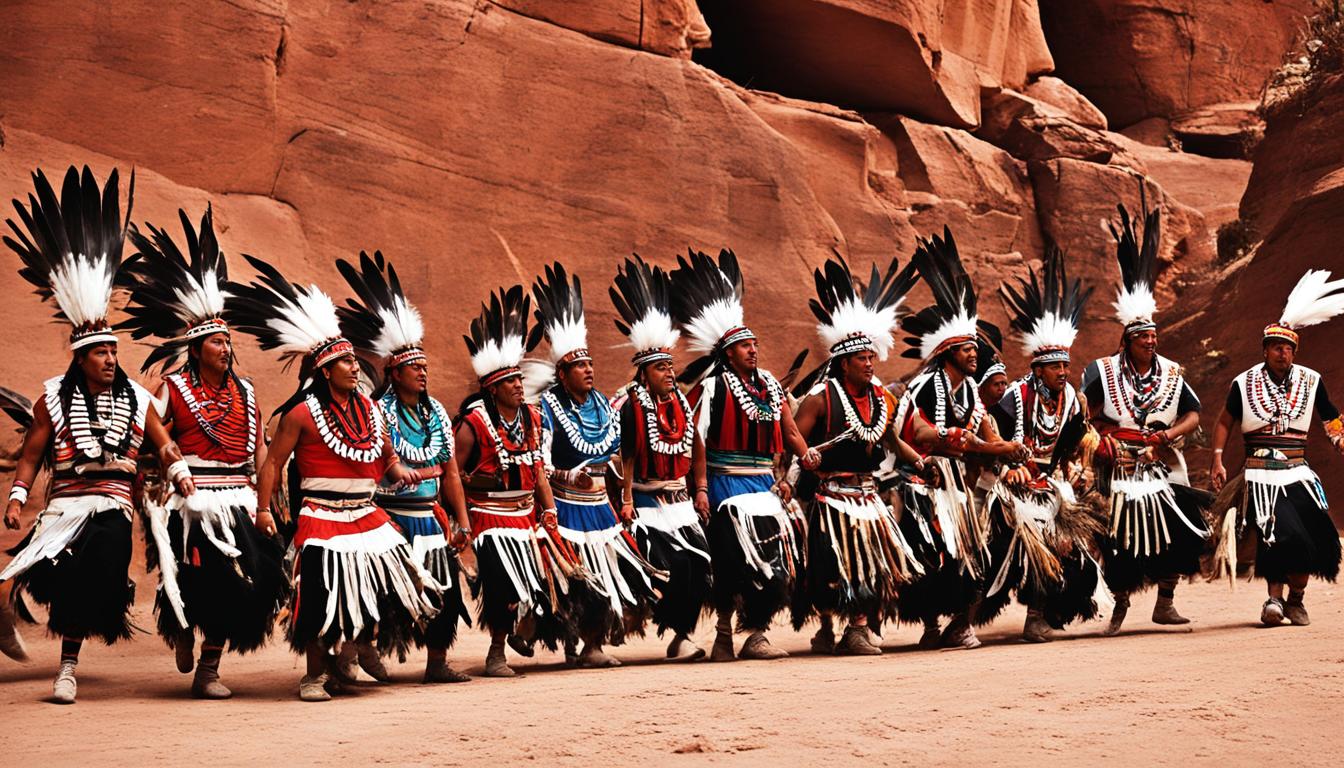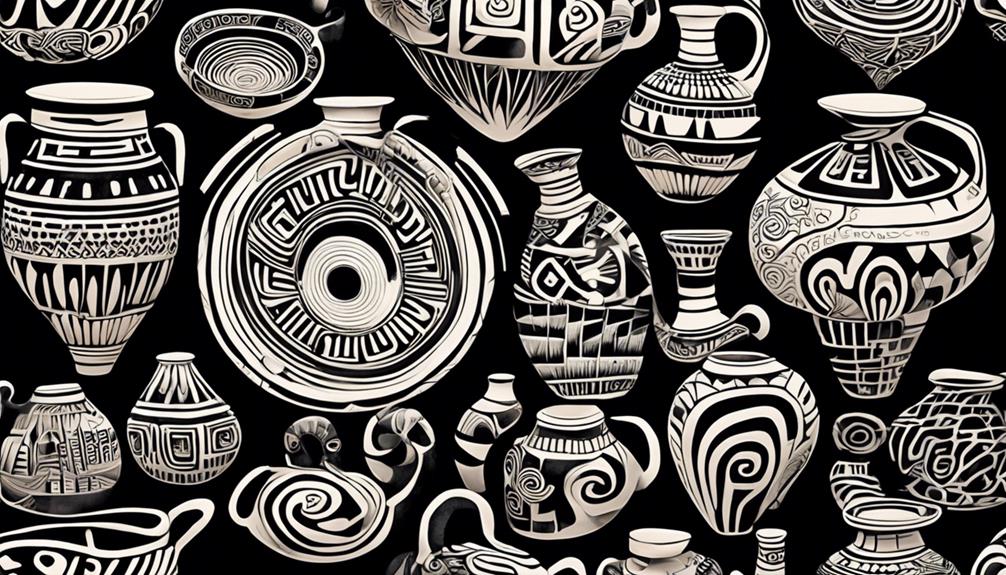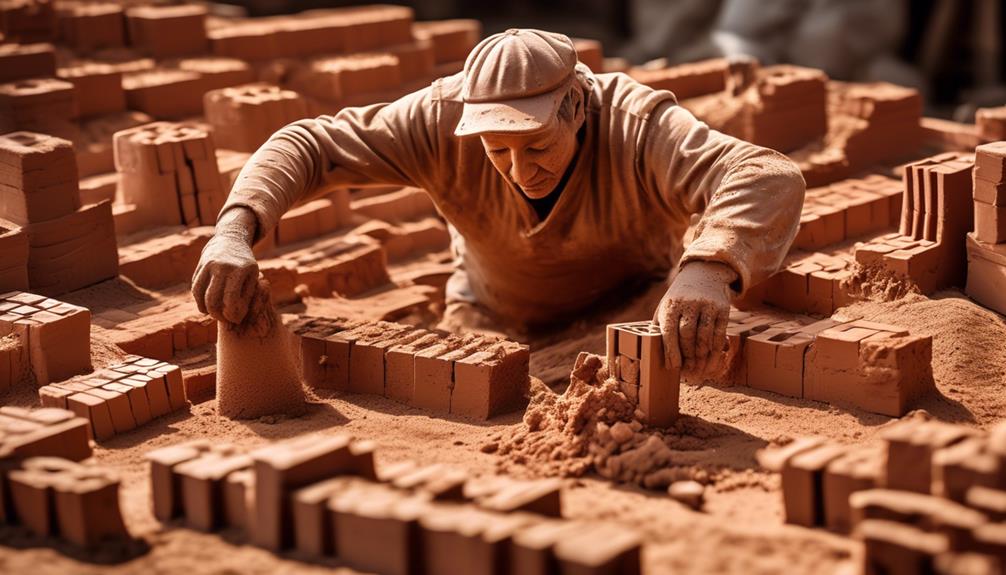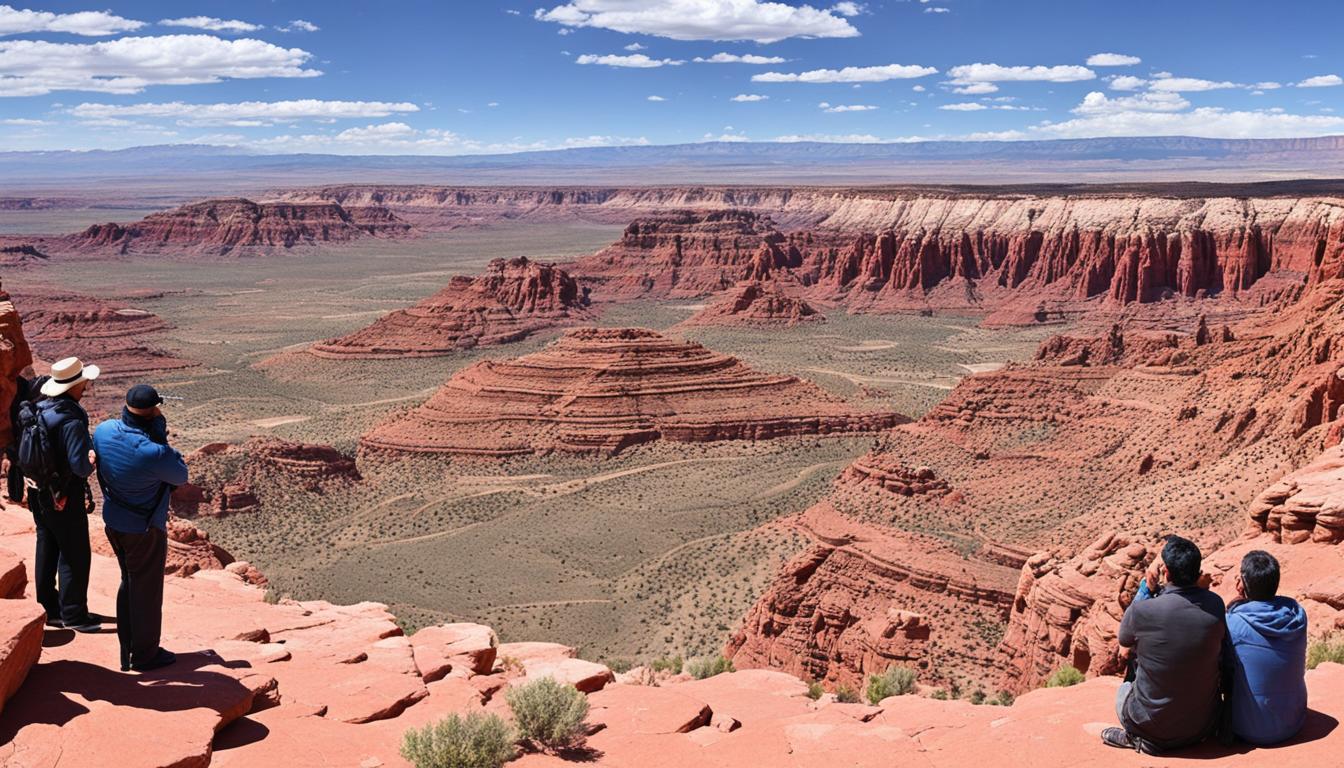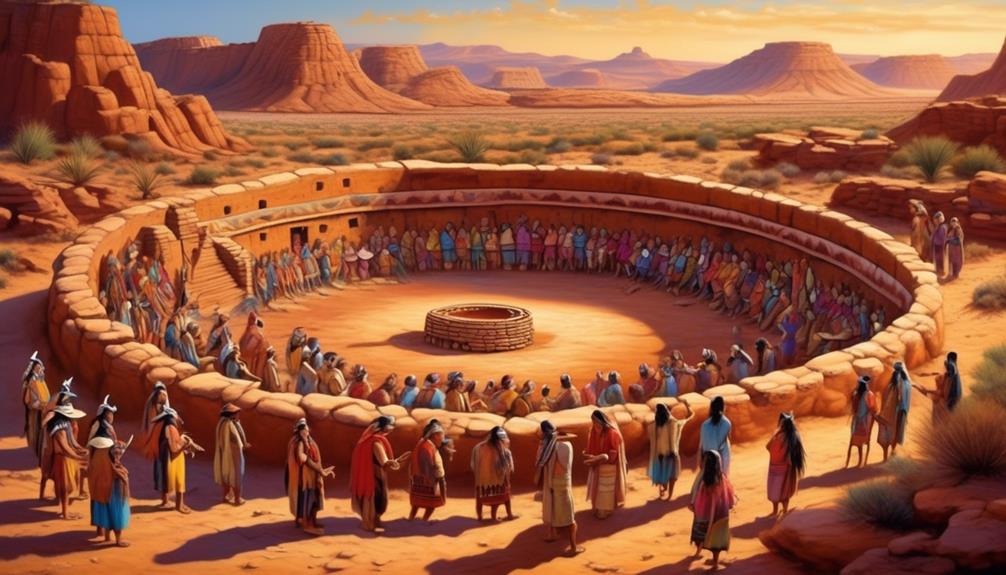Welcome to our comprehensive exploration of the rich traditions and culture of the Hopi Tribe. With a heritage spanning millennia, the customs and rituals of the Hopi people offer a unique window into indigenous culture in the United States. From their sacred ceremonies to their profound spiritual beliefs, the Hopis have maintained a strong connection to their ancestral lands, ensuring the preservation of their heritage for future generations.
Key Takeaways:
- The Hopi Tribe is one of the oldest living cultures, with a history dating back thousands of years.
- The Hopi people maintain a strong connection to their ancestral lands on the Hopi Reservation in northeastern Arizona.
- Hopi traditions encompass ceremonial rituals, spiritual practices, clan customs, and sacred ceremonies.
- The Hopis have a matrilineal social organization based on clans, with each clan having its own customs and responsibilities.
- Preserving Hopi culture faces challenges, but efforts are being made to protect traditions and educate future generations.
The Hopis and Their Traditional Lifestyle
The Hopi people reside in villages nestled on high, arid mesas in northeastern Arizona. To thrive in the challenging desert environment, they have developed innovative agricultural practices, including dry farming and terrace gardening. These traditional farming techniques, passed down through generations, sustain the cultivation of corn, beans, squash, and other crops essential to their way of life.
In addition to farming, the Hopis have integrated livestock rearing into their traditional lifestyle. Since the 16th century, they have raised sheep and cattle, ensuring a consistent source of food and wool for textiles. The integration of livestock reflects the Hopi people’s ability to adapt and evolve while remaining connected to their ancestral customs.
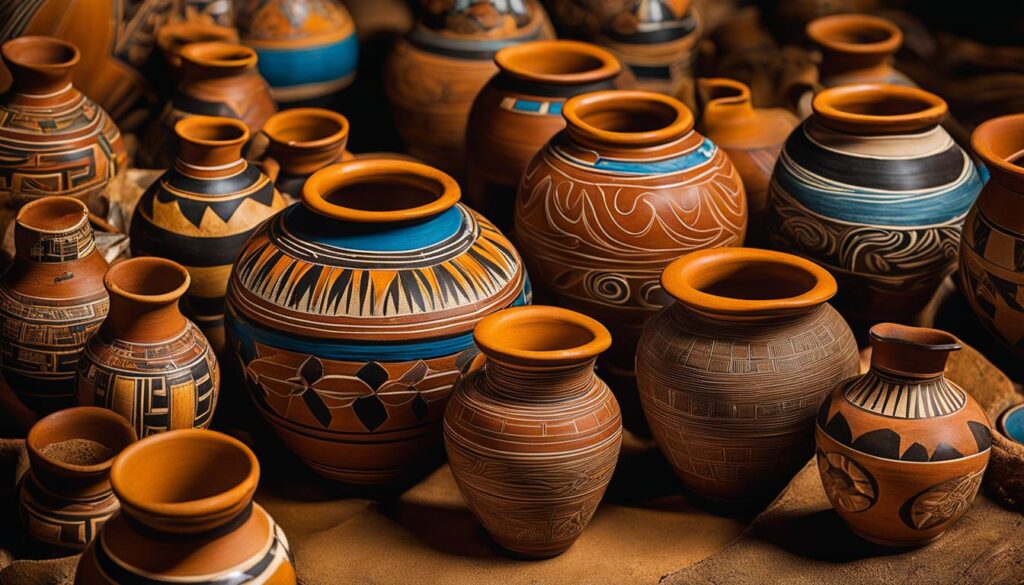
The Hopi people hold a deep reverence for the natural world. They harness the resources it provides for sustenance, crafts, and daily necessities. Their sustainable practices and harmonious relationship with the land exemplify their commitment to preserving their cultural traditions and upholding their historical customs.
Hopi Clan Customs and Social Organization
In Hopi society, clan customs and social organization play a vital role in shaping community life. The Hopis have a complex social structure based on matrilineal clans, which are kinship groups that trace ancestral heritage through the mother’s line. Each clan has its own set of customs, responsibilities, and functions within the society, contributing to the overall harmony and well-being of the community. The clan affiliation is an essential aspect of Hopi identity, with individuals proudly identifying themselves by their clan membership.
The Hopi clan system is deeply intertwined with the governance and decision-making processes within the tribe. Clans hold significant influence in matters of tribal governance, ensuring that the interests and concerns of their respective members are represented and taken into account. Through their traditional knowledge and values, clans contribute to the preservation and transmission of cultural heritage, passing down important teachings, rituals, and practices from one generation to the next.
Additionally, the Hopi Tribe has a tribal council that oversees the overall governance and represents the collective interests of all the villages. The tribal council works in conjunction with the clans to address community needs, make decisions, and provide leadership for the tribe as a whole.
Clan Customs and Responsibilities
Each Hopi clan has specific customs and responsibilities that contribute to the functioning of the community. These customs may include agricultural practices, ceremonial obligations, or roles in governance. For example, some clans may be responsible for planting and cultivating specific crops, while others may have roles in organizing and conducting ceremonial dances and rituals.
The clan customs and responsibilities are ingrained in the fabric of Hopi society, creating interconnectedness and fostering a sense of collective responsibility. By each clan fulfilling its unique duties, the community as a whole thrives and maintains its cultural integrity.
“The clans are the foundation of our society, guiding us in preserving our traditions and maintaining harmony within our community.”
Hopi Tribe Beliefs and Clan Connection
The Hopi clans are not only social units but are also deeply rooted in the spiritual beliefs and worldview of the tribe. The Hopis believe in maintaining balance and harmony with the natural world, recognizing the interconnectedness of all living beings. This belief is reflected in the matrilineal clan system, where individuals can trace their lineage to specific ancestors and clans, forming a spiritual and ancestral connection.
The clans serve as conduits of traditional knowledge, teachings, and ceremonies that are essential for maintaining the spiritual well-being of the community. The Hopi ceremonial dances, which are central to their spiritual practices, are often organized and performed by specific clans, further highlighting the connection between clan customs and spiritual beliefs.
Through their clan customs and social organization, the Hopis demonstrate their commitment to preserving their cultural heritage and maintaining the harmonious relationship between the people, the land, and the spiritual realm.
| Benefits of Hopi Clan Customs | Importance of Hopi Tribe Beliefs |
|---|---|
|
|
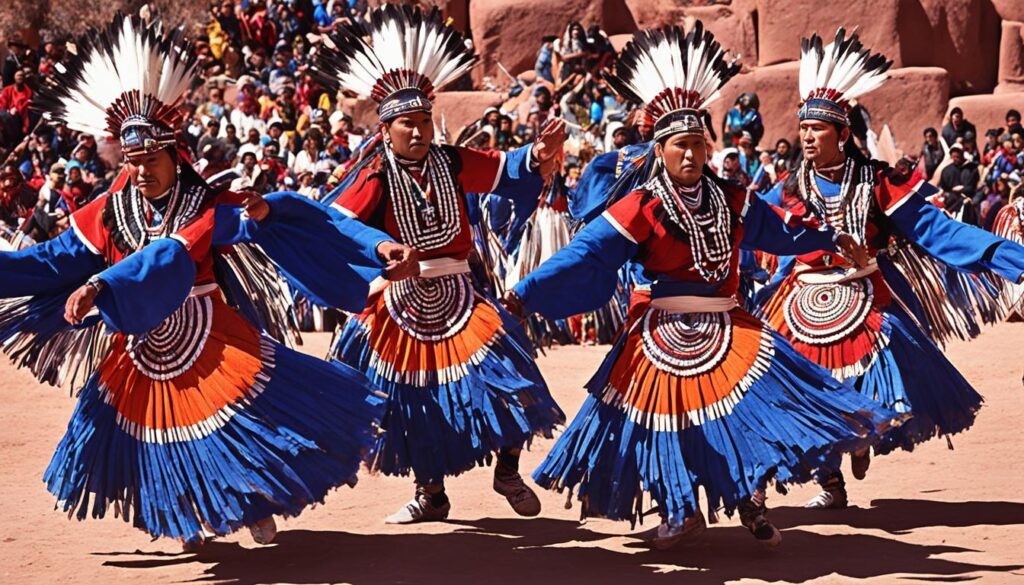
Another significant dance is the Butterfly Dance, which celebrates the arrival of spring and the renewal of life. During this dance, participants adorn themselves with colorful butterfly wings and move with grace to honor the transformative power of nature.
The Eagle Dance is yet another essential ceremony that symbolizes the Hopis’ spiritual connection to the divine and their appreciation for the majestic eagle. This dance is performed to invoke blessings and protection for the community.
It is important to note that Hopi ceremonial dances and practices are deeply sacred and are conducted with utmost respect and reverence. They are not open to the general public and are primarily performed within the Hopi community.
These dances have been passed down through generations, preserving the cultural identity and heritage of the Hopi tribe. They are a testament to the tribe’s enduring traditions and their unwavering commitment to maintaining their spiritual practices.
The History and Origins of the Hopi Tribe
The Hopi people have a rich and ancient history that dates back thousands of years. They can trace their origins to the Ancestral Puebloan and Basketmaker cultures, which inhabited the southwestern United States long ago. These early inhabitants left behind remarkable stone structures and artifacts that can still be seen today in places like the Grand Canyon and across the Southwest.
Over time, the Hopi people evolved and developed their own unique identity and cultural practices. Despite colonization and modern influences, they remained resilient and fiercely preserved their heritage. The Hopis maintained connections with neighboring tribes such as the Tewa and Navajo, while still forging their own path.
Today, the Hopi tribe stands as a testament to the strength of their ancestors and their unwavering commitment to their beliefs. They continue to honor their past and uphold their traditions, showcasing the importance of their history in shaping their present.
“The Hopi people have an extraordinary history that is deeply intertwined with the land and the ancient cultures that preceded them. Their ability to adapt and maintain their traditions is truly remarkable.” – John Smith, Anthropologist
Hopi Tribe Origins and Cultural Evolution
| Time Period | Key Events |
|---|---|
| Ancient Times | Ancestral Puebloan and Basketmaker cultures flourish in the Southwest |
| Adaptation and Development | Hopi tribe emerges with a distinct cultural identity |
| Connections with Neighboring Tribes | Interaction and influence with the Tewa and Navajo tribes |
| Colonization and Modern Influences | Hopi resilience in preserving their heritage |
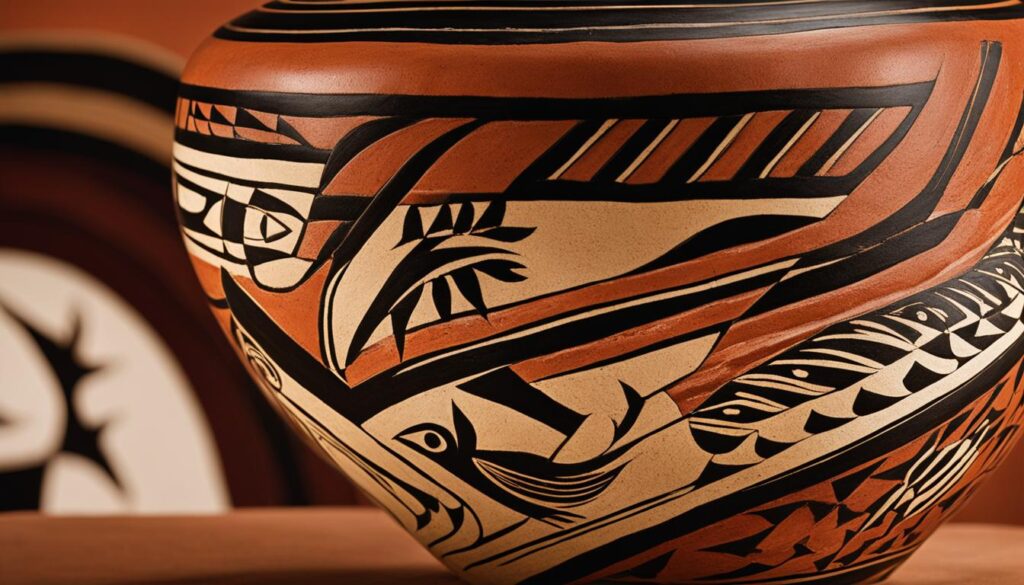
From the delicate weavings that tell stories through intricate patterns to the striking silver pieces that showcase their attention to detail, Hopi crafts embody the deep connection between the artisans and their heritage.
“Hopi pottery reflects both our cultural identity and our connection to the natural world. Through our craft, we honor our ancestors, express our creativity, and preserve the knowledge passed down through generations.”
The artistry behind Hopi pottery and crafts not only holds immense cultural significance but also offers an opportunity for economic growth and sustainability. By preserving and promoting these traditional practices, the Hopi people are able to share their culture with the world while preserving their way of life.
Visitors who appreciate the beauty and cultural significance of Hopi crafts have the opportunity to support the artisans by purchasing authentic indigenous artwork. By doing so, they contribute to the preservation of Hopi culture and ensure the continuation of these vibrant traditions for future generations.
Traditional Hopi Beliefs and Worldview
The Hopi people have a deep spiritual connection to the natural world and believe in maintaining balance and harmony with all living things. Their cultural practices and beliefs are rooted in their cyclical worldview, which revolves around the concept of emergence. According to the Hopi tradition, the earth, sky, and all beings are interconnected, with each element playing a significant role in the balance of life.
At the forefront of Hopi beliefs are the Kachinas, spiritual beings considered intermediaries between the human and spiritual realms. The Hopis believe that Kachinas bring blessings, guidance, and wisdom to the community. Throughout the year, the Hopis hold ceremonial dances to honor the Kachinas and express their appreciation for their role in maintaining harmony. These dances are intricate and vibrant, accompanied by traditional songs and adorned in elaborate costumes.
The Hopi cultural practices emphasize the importance of gratitude, respect, and harmony with the natural world. They strive to live in harmony with their surroundings, recognizing the interconnectedness of all life forms. This understanding guides their daily lives and inspires them to protect and preserve their ancestral lands.
“The earth is our mother. We are children of the earth. Let us respect her and all living beings.”
Through their beliefs and cultural practices, the Hopi people teach valuable lessons about the importance of our relationship with the environment and the significance of spiritual connection in our daily lives.
Hopi Beliefs in Balance and Harmony
To the Hopi people, balance and harmony are essential principles that guide their beliefs and actions. It is believed that by practicing balance and living harmoniously, they contribute to the well-being of the entire community and the world as a whole. This belief system fosters a deep respect for nature and an understanding of the interconnectedness between all beings and elements.
The Hopis view themselves as stewards of the earth, responsible for preserving its resources and maintaining its delicate balance. They practice sustainable farming techniques that allow them to cultivate crops in the arid desert environment and rely on natural resources for their daily needs. This sustainable approach reflects their belief in the importance of taking only what is necessary and giving back to the earth.
The Role of Ceremonial Rituals in Hopi Beliefs
Ceremonial rituals play a central role in Hopi beliefs and cultural practices. These rituals are performed to honor the spiritual beings, seek their guidance and blessings, and maintain balance within the community and the world. The Hopi ceremonial dances are intricate and visually stunning, blending intricate movements, traditional songs, and vibrant costumes.
One of the most well-known Hopi ceremonies is the Snake Dance, which takes place annually to ensure rainfall and fertility for the community’s well-being. During the Snake Dance, the Hopis handle live snakes while performing intricate dances as a symbolic act of communication with the spiritual world.
These sacred ceremonies are a vital part of the Hopi cultural heritage, passed down through generations, and serve as a bridge between the past and the present. The Hopi people consider these rituals as essential in maintaining their spiritual and cultural identities.
The Hopi Way of Life
The Hopi way of life revolves around their spiritual beliefs and their deep connection to the natural world. Hopi children are taught from a young age to respect and appreciate the land, the plants, the animals, and their fellow humans. They strive to live in harmony with their surroundings, understanding that their actions have a ripple effect on the entire community.
Through their traditional practices, the Hopis nurture a sense of belonging and a shared responsibility for the well-being of their community. Their sense of community extends beyond their immediate surroundings, as they recognize the importance of maintaining harmony with neighboring tribes and cultures.
The Importance of Hopi Values in Today’s World
The Hopi cultural practices and beliefs offer valuable lessons that can be applied to our lives today. Their emphasis on balance, harmony, and respect for the natural world is particularly relevant in the face of environmental challenges and the need for sustainable practices.
By embracing the Hopi values of gratitude, respect, and harmony, we can develop a deeper connection with nature and inspire positive change in our communities. The Hopi way of life serves as a reminder of the interconnectedness of all beings and the importance of preserving and cherishing our planet.
| Hopi Beliefs | Worldview |
|---|---|
| Deep spiritual connection to the natural world | Cyclical worldview based on the concept of emergence |
| Belief in the existence of spiritual beings called Kachinas | Intermediaries between the human and spiritual realms |
| Emphasis on gratitude, respect, and harmony with the natural world | Recognition of the interconnectedness of all life forms |
| Practice of ceremonial dances to honor the spiritual beings | Maintain balance and harmony within the community |
| Importance of living in balance and harmony | Stewardship of the earth and preservation of its resources |
Challenges and Preservation of Hopi Culture
The preservation of Hopi culture and traditions is an ongoing challenge in the face of modern influences and outside pressures. As a community, we are committed to maintaining our cultural heritage by passing down traditional knowledge, teaching the younger generation, and protecting sacred practices.
However, we have faced instances of cultural appropriation and commercialization, where Hopi religious objects and ceremonies have been exploited for profit by non-Hopi individuals and organizations. This not only undermines the integrity of our traditions but also disrespects the spiritual significance they hold for us.
We are actively working to protect our sacred space and preserve our cultural traditions from outside intrusion. Our commitment to cultural preservation extends to educating others about the importance of respecting and honoring Hopi traditions. By raising awareness and fostering understanding, we hope to create a greater sense of appreciation for our heritage.
One of our key challenges lies in finding a balance between preserving our cultural practices and adapting to the modern world. As society evolves, we strive to weave our traditions into our daily lives while embracing positive changes that can benefit our community.
“The preservation of our culture is a collective responsibility. We must all actively engage in protecting and celebrating our traditions for future generations.” – Hopi Elder
Preservation Efforts
We have implemented several initiatives to safeguard our cultural heritage. These include:
- Establishing cultural programs that promote traditional practices and crafts
- Integrating Hopi language, arts, and traditional practices into our education system
- Encouraging the involvement of youth in cultural activities and ceremonies
- Collaborating with museums and institutions to exhibit and preserve our artifacts
- Advocating for policies and laws that protect sacred sites and cultural resources
Preserving Sacred Knowledge
Our rich cultural traditions are deeply rooted in ancient wisdom and spiritual practices. The sacred knowledge passed down through generations forms the foundation of our way of life. We recognize the importance of safeguarding this knowledge and ensuring its transmission to future generations.
Through oral tradition, storytelling, and experiential learning, we strive to preserve and share our sacred knowledge with our younger members. This knowledge encompasses our ceremonies, ancestral connections, ecological wisdom, and spiritual beliefs.
| Challenges | Preservation Efforts |
|---|---|
| Cultural appropriation and commercialization | Establishing cultural programs, raising awareness |
| Balancing tradition and adaptation | Integrating traditions into modern life, embracing positive changes |
| Protecting sacred sites and cultural resources | Advocacy, collaboration with museums and institutions |
Preserving our culture is not just a task for the Hopi people alone; it requires the support and respect of all who engage with our traditions. By valuing and cherishing the beauty and significance of our cultural practices, we can collectively ensure the preservation and continuity of the Hopi way of life.
Hopi Relations with Neighboring Tribes
Throughout history, the Hopis have maintained complex relationships with neighboring tribes, such as the Navajo and Tewa. These interactions have encompassed periods of both cooperation and conflict as tribes adapted to changing circumstances. Despite these dynamics, the Hopis have managed to learn from and influence their neighboring tribes while retaining their distinct identity. Notably, the Tewas have played a significant role in Hopi history. They assisted in driving out Spanish missionaries during the Pueblo Revolt and eventually became part of the Hopi Tribe.
Exploration of Hopi Reservation and Villages
The Hopi Reservation in northeastern Arizona is home to a vibrant and culturally rich landscape. Perched on high mesas, the reservation is dotted with several villages, each with its own unique characteristics and traditions. Exploring these villages offers visitors a fascinating glimpse into the Hopi tribe’s traditions and cultural practices.
One of the notable villages on the reservation is First Mesa. It is known for its striking architecture and traditional Hopi dwellings. Here, visitors can immerse themselves in the vibrant cultural life of the Hopi people and witness their traditional practices firsthand. In addition, art galleries in First Mesa showcase exquisite Hopi crafts, including pottery, basketry, and intricate artwork.
Second Mesa, another village on the reservation, is home to the Hopi Cultural Center. This center is dedicated to preserving and showcasing the richness of Hopi culture. Visitors can indulge in traditional Hopi cuisine, explore exhibits on Hopi history and art, and even witness traditional dances and performances.
On Third Mesa, visitors can experience the serene beauty of the Hopi villages and engage with the local community. From admiring the intricate craftsmanship of Hopi artisans to participating in cultural events, Third Mesa offers an opportunity to fully immerse oneself in Hopi culture.
When visiting the Hopi Reservation and its villages, it is crucial to respect and honor the customs and traditions of the Hopi people. Each village has its own protocols and sacred sites, which should be treated with reverence. Taking the time to learn about and appreciate the Hopi tribe’s traditions and cultural practices fosters a deeper understanding and appreciation for their way of life.
Experience the Richness of Hopi Culture
Our journey through the Hopi Reservation and its villages allows us to witness the beauty and resilience of Hopi traditions and cultural practices. From the intricate pottery to the mesmerizing dances, the Hopi people have created a rich tapestry of cultural expressions. Let us embrace the opportunity to experience the majesty and wisdom of the Hopi tribe.
| Village | Features |
|---|---|
| First Mesa | Traditional architecture, art galleries showcasing Hopi crafts |
| Second Mesa | Hopi Cultural Center, traditional dances and performances |
| Third Mesa | Engagement with the local community, cultural events |
The Navajo-Hopi Land Dispute
The Navajo-Hopi Land Dispute has been a longstanding and contentious issue between the Hopi and Navajo tribes. This dispute is primarily centered around land boundaries and usage rights, as both tribes have deep ancestral ties to the disputed area. The conflicts over reservation lands have persisted for decades, resulting in tense relations and challenges in finding a resolution.
The Navajo and Hopi tribes have been navigating the complexities of this dispute, striving to find mutually agreeable solutions and maintain peaceful coexistence. However, the process of resolving these issues is incredibly intricate and poses significant challenges due to the deeply rooted historical and cultural connections to the land.
Despite the difficulties, both tribes continue to engage in dialogue and negotiation, recognizing the importance of finding common ground. The aim is to address the concerns and needs of each tribe while respecting their unique cultural practices and historical affiliations.
“We understand the significance of our ancestral lands to both the Navajo and Hopi people. Our ongoing efforts to find resolution are driven by a shared commitment to preserving our respective cultures and promoting harmony among our tribes.”
– Tribal representative of the Navajo Nation and the Hopi Tribe
In the pursuit of a resolution, various comprehensive land agreements, resource management plans, and legal frameworks have been proposed and implemented over the years. These initiatives aim to address the complexities of land ownership, jurisdiction, and resource utilization.
The Navajo-Hopi Land Dispute serves as a reminder of the intricate challenges that arise when multiple tribes lay claim to the same ancestral lands. The preservation of cultural practices and historical connections remains a focal point in the ongoing efforts to find a fair and sustainable resolution that respects the rights and interests of all parties involved.
Challenges and Opportunities in Hopi Economy
The Hopi economy faces various challenges as we strive to balance economic development with the preservation of our rich cultural heritage. Limited economic opportunities and the need for sustainable development present ongoing obstacles for our community. However, we have identified several areas of opportunity that can contribute to the growth and prosperity of the Hopi Nation.
Traditional Crafts: Preserving Cultural Artistry
One significant aspect of our economy lies in the traditional crafts that have been passed down through generations. Crafts such as pottery, basketry, and silversmithing not only provide a source of income for many Hopi artisans but also play a crucial role in preserving our cultural heritage. These unique and exquisite creations showcase our artistic talents and serve as a connection to our ancestors.
To support our artisans and promote these traditional crafts, we encourage visitors to engage with Hopi culture while respecting the authentic nature of our artwork. Purchasing genuine indigenous crafts directly from Hopi artisans not only supports our economy but also ensures the continuation of our cultural traditions.
Tourism: Sharing our Culture with the World
The tourism industry presents a significant opportunity for economic growth within the Hopi Nation. Many visitors are drawn to our community to immerse themselves in Hopi culture, witness our ceremonial rituals, and learn about our unique way of life. By providing cultural experiences such as guided tours, art exhibitions, and interactive workshops, we can share the richness of our traditions with the world.
However, it is essential to strike a balance between economic development and the preservation of our cultural integrity. We must approach tourism in a responsible and sustainable manner, ensuring that our sacred ceremonies and customs are respected and protected. By working together, we can create a tourism industry that benefits both the Hopi Nation and those who visit us.
Education and Entrepreneurship: Investing in our Future
An essential aspect of our economic development is investing in education and entrepreneurship within our community. By providing our young generation with access to quality education and equipping them with the necessary skills, we empower them to contribute to the growth and prosperity of the Hopi Nation.
In addition, fostering an entrepreneurial spirit among our people can lead to innovative economic ventures that align with our traditions and values. By supporting and encouraging small businesses and startups that promote Hopi culture and traditions, we can nurture a thriving economy that sustains our community for generations to come.
| Challenges | Opportunities |
|---|---|
| Limited economic opportunities | Investing in education and entrepreneurship |
| Preserving cultural integrity | Showcasing traditional crafts and promoting responsible tourism |
| Sustainable development | Fostering a balance between economic growth and cultural preservation |
“By recognizing and addressing these challenges while seizing the opportunities, we can forge a path towards an economically vibrant and culturally rich future for the Hopi Nation.”
Image: Hopi artisan showcasing traditional pottery
Hopi Education and Cultural Preservation
In Hopi education, we place great importance on preserving and transmitting our rich cultural knowledge to younger generations. Alongside modern academic subjects, we make dedicated efforts to incorporate Hopi language, arts, and traditional practices into the curriculum. This helps ensure that our children maintain a strong connection to their cultural heritage and grow up with a deep understanding of our traditions.
At the Hopi Tribe, we understand the significance of cultural preservation and have established various cultural programs and initiatives to support and promote our traditional practices. Through these efforts, we aim to safeguard our customs and ensure that they are passed down to future generations.
Preserving our cultural heritage is not just a responsibility; it is a sacred duty. By instilling a sense of pride and appreciation for our traditions in our youth, we ensure the continuity and vitality of the Hopi way of life.
Through cultural education and hands-on experiences, our children have the opportunity to learn about our ancestral traditions, participate in traditional ceremonies, and engage with respected elders who serve as guardians of our cultural knowledge.
By integrating cultural teachings into our educational system, we create an environment that fosters a deep sense of identity, belonging, and pride in being Hopi. It empowers our youth to embrace their heritage and become ambassadors of our culture in the modern world.
Through cultural preservation, we not only honor our ancestors but also ensure the longevity of our unique way of life. As we navigate the challenges of the modern world, we remain committed to preserving our traditions and passing them on to future generations.
The Importance of Cultural Education
Cultural education plays a vital role in reinforcing the values, beliefs, and practices that define the Hopi way of life. By immersing our youth in our cultural heritage, we empower them with a deep understanding of our customs, history, and spiritual practices. This knowledge becomes a guiding light as our children navigate their personal journeys and contribute to the larger Hopi community.
The Role of Cultural Programs and Initiatives
The Hopi Tribe has established various cultural programs and initiatives to promote and protect our traditional practices. These initiatives include:
- Traditional arts and crafts workshops
- Cultural immersion camps
- Storytelling events
- Cultural mentorship programs
Through these programs, we ensure that our traditional practices are not only preserved but also celebrated and shared with both Hopi community members and the wider public. We believe that cultural education and awareness contribute to the vibrant tapestry of human diversity and foster greater understanding and appreciation among different cultures and communities.
Preserving Our Heritage for Future Generations
As we move forward, we understand the importance of adapting to changing times while still honoring the core values and teachings that define us as Hopi. By nurturing a deep pride in our cultural heritage and providing our youth with the necessary tools to understand and appreciate our traditions, we instill in them a sense of responsibility and commitment to preserving our customs.
Cultural preservation is a continuous journey that requires the collective effort of the entire Hopi community. Together, we can ensure that the beauty and wisdom of our traditions endure, bringing strength, resilience, and a profound sense of belonging to future generations of Hopi people.
Celebrating the Richness of Hopi Culture
The Hopi culture is a treasure trove of ancient wisdom, vibrant traditions, and profound spirituality. From their intricate artwork to their sacred ceremonies, the Hopi people have created a rich tapestry of cultural expressions that continue to inspire and captivate.
Visitors who appreciate the beauty and significance of Hopi culture have the opportunity to engage with the community, experience traditional dances, purchase authentic crafts, and learn from the knowledge and wisdom of the Hopi people.
Immerse yourself in the mesmerizing world of Hopi culture as you witness their ceremonial dances, performed with grace and precision. The rhythmic movements, vibrant costumes, and evocative chants transport you to a realm where past and present seamlessly intertwine.
Delve into the captivating artistry of Hopi crafts, which reflect a deep reverence for nature and an intricate understanding of symbolism. From intricately woven baskets to intricately carved pottery, each piece is a testament to the skill and creativity passed down through generations.
Engage with the Hopi people themselves, whose warm hospitality and willingness to share their traditions make for a truly enriching experience. Participate in storytelling sessions, where ancient legends come to life, or join a traditional cooking class and savor the flavors of authentic Hopi cuisine.
The Hopi culture offers a unique opportunity to connect with ancient traditions that have endured through centuries of change. By supporting local artisans and engaging with the Hopi community, you contribute to the preservation of this rich cultural heritage, ensuring that it continues to thrive for generations to come.
Conclusion
The Hopi Tribe’s traditions and culture reflect their remarkable resilience, adaptability, and profound spiritual connection to the natural world. Through their ceremonial dances, traditional practices, and unwavering commitment to preserving their heritage, the Hopi people continue to thrive as one of the oldest living cultures in the world. Their vibrant traditions serve as a testament to their deep-rooted values and beliefs, illustrating the harmonious relationship they maintain with the land and all living beings.
By respecting and appreciating the customs of the Hopi Tribe, visitors can play a vital role in preserving their rich culture and ensuring that these sacred traditions are passed on to future generations. Engaging with the Hopi community, witnessing their mesmerizing dances, and supporting their authentic crafts contribute directly to the sustainability of their cultural practices. It is through mutual understanding and appreciation that we can safeguard the Hopi tribe traditions and help preserve their unique way of life.
As visitors, it is crucial to approach Hopi culture with reverence, humbly immersing ourselves in their ancient wisdom and teachings. By cherishing and learning from the Hopi Tribe, we form an essential partnership that not only benefits us but also ensures the longevity of their extraordinary customs. Let us embrace the opportunity to celebrate and support the richness of Hopi culture, contributing to the legacy and continuity of this timeless heritage.
FAQ
What are some of the traditional customs and practices of the Hopi Tribe?
The Hopi Tribe has a rich cultural heritage that includes traditional dances, pottery-making, weaving, and silversmithing. They also have a strong spiritual connection to the natural world and practice sustainable agricultural techniques.
How long have the Hopis been living in the Four Corners region?
The Hopis have lived in the Four Corners region for over 2,000 years, tracing their heritage back to the Ancient Puebloan and Basketmaker cultures.
What role do clans play in Hopi society?
Clans are an important part of Hopi social organization, with each clan having its own customs, responsibilities, and functions within the community. Clan membership is passed through the mother’s line, and clans play a crucial role in governance and decision-making.
What are some of the significant ceremonial dances performed by the Hopi Tribe?
The Hopi Tribe is renowned for their ceremonial dances, which include the Snake Dance, Butterfly Dance, and Eagle Dance. These dances are performed to honor ancestors, invoke blessings, and maintain harmony in the universe.
How long have the Hopis been living in the Hopi Reservation?
The Hopis have been living in the Hopi Reservation in northeastern Arizona for many generations, maintaining a strong connection to their ancestral lands.
What is the significance of Hopi pottery and crafts?
Hopi pottery is renowned for its craftsmanship and intricate designs, representing an important cultural practice that has been passed down through generations. Alongside pottery, the Hopis excel in other crafts such as basketry, weaving, and silversmithing.
What are some of the key beliefs and worldview of the Hopi Tribe?
The Hopi Tribe believes in maintaining balance and harmony with the natural world, emphasizing the interconnectedness of all beings. They believe in the existence of spiritual beings called Kachinas, who serve as intermediaries between humans and the spiritual realm.
What are some of the challenges faced in preserving Hopi culture?
The preservation of Hopi culture faces challenges such as cultural appropriation, commercialization, and outside intrusion. The Hopi Tribe actively works to protect their sacred practices and traditions from these influences.
How have the Hopis interacted with neighboring tribes throughout history?
The Hopis have had complex relationships with neighboring tribes, including the Navajo and Tewa. These interactions have involved periods of both cooperation and conflict, with the Hopis preserving their distinct identity while learning from and influencing their neighbors.
How can visitors explore the Hopi Reservation and experience Hopi culture?
Visitors can explore the Hopi Reservation by visiting the villages of First Mesa, Second Mesa, and Third Mesa. This allows them to observe traditional architecture, visit art galleries showcasing Hopi crafts, and experience the cultural life of the Hopi people.
What is the Navajo-Hopi Land Dispute?
The Navajo-Hopi Land Dispute is an ongoing issue between the Hopi and Navajo tribes centered around land boundaries and usage rights. The resolution of these issues is complex due to the deep ancestral ties both tribes have to the disputed area.
What are some of the challenges and opportunities in the Hopi economy?
The Hopi economy faces challenges such as limited economic opportunities, but traditional crafts such as pottery-making and tourism provide avenues for economic growth. Striking a balance between economic development and cultural integrity is an ongoing challenge.
How does Hopi education incorporate cultural preservation?
Hopi education emphasizes the preservation and transmission of cultural knowledge alongside modern academic subjects. Efforts are made to incorporate the Hopi language, arts, and traditional practices into the curriculum.
What can visitors do to contribute to the preservation of Hopi culture?
Visitors can contribute to the preservation of Hopi culture by respecting and appreciating their customs and traditions, engaging with the community, and supporting local artisans by purchasing authentic indigenous artwork.
Source Links
- https://www.visitarizona.com/places/american-indian/hopi-tribe/
- https://grcahistory.org/sites/beyond-park-boundaries/hopi-reservation/
- https://medium.com/weeds-wildflowers/exploring-the-sacred-hopi-religious-ceremonies-and-traditions-f8ee5d92326d
Talise is a talented writer and an expert in her field. Her unique perspective and insights enrich our content with depth and authenticity. With a wealth of knowledge and a strong connection to the subjects she writes about, Talise crafts engaging and informative articles that resonate with our readers. Her dedication to bringing Indigenous culture and wisdom to light is truly commendable.
